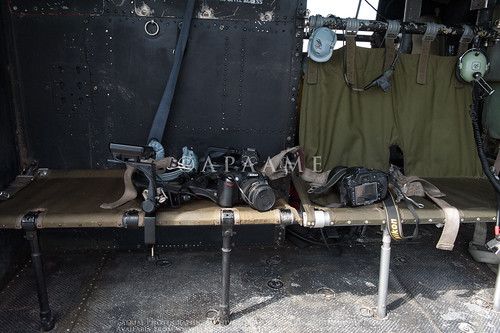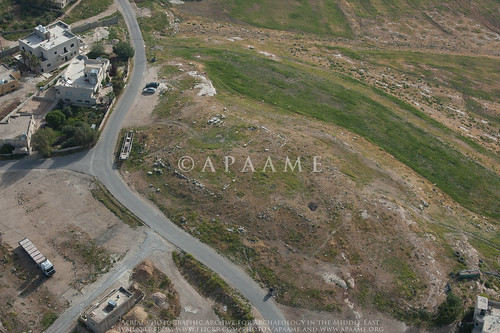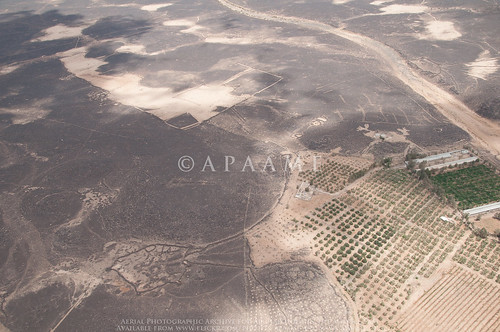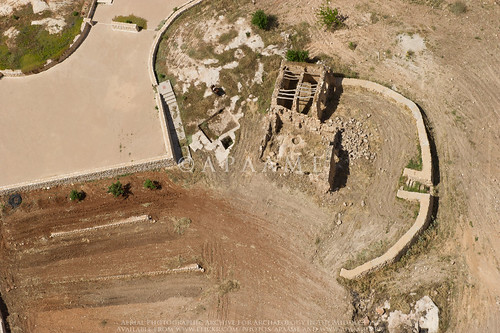 |
| Tools of the trade.
APAAME_20130418_DLK-0310. Photo: David Kennedy. |
The 2013 flying season in Jordan extended over a month and comprised of four flights:
20130409, 20130414, 20130418 and 20130428 which can now be accessed on our Flickr site; and five ground fieldtrips: 20130412, 20130416, 20130419, 20130430 and 20130502. Despite some very inclement weather in the month of April, somehow the flying days remained clear and four successful flights were conducted, sadly the first cut short to just two legs out of three due to technical difficulties.
All photographs from the flights are now online. Direct links to the flight photosets on Flickr are provided with the flight summaries below. We continue to provide all photographs ‘warts and all’ online as you may very well be interested in a different aspect of our photography and/or spot something that we haven’t in a ‘bad’ photo. If you do so please do not hesitate to let us know!
 |
| Ghussein Settlement 2. APAAME_20130409_RHB-0049. Photo: Robert Bewley. |
20130409: to the east over the basalt desert.
Bernd Mueller-Neuhof of the Deutsches Archäologisches Institut
accompanied us on this flight to aid us in identifying and recording sites pertinent to his project ‘Arid Habitats in the 5th to the Early 3rd Millennium BC: Mobile Subsistence, Communication and Key Resource Use in the Northern Badia (NE-Jordan)’. This included stone structures and possible settlement areas built on the basalt landscape, such as the Bronze Age site and water farming structures of Jawa, but also flint mines located beyond the eastern edge of the lavafield.
 |
| Umm el-Hanafish. APAAME_20130414_REB-0028. Photo: Rebecca Banks. |
20130414: This flight sought to illuminate for us of the condition of sites located within the hinterland of Amman, ancient Philadelphia. Some sites are well known ruins and have been investigated. Many sites are recorded as possible ruins by 19th century travellers or marked as ruins on maps created during the middle 20th century drawn from topographical survey photographs, but little is known of them since those notations. Sites were difficult to see or investigate due to their location either amongst the expanding suburbs of Amman or in a fertile area with continued farming, habitation, and even lush spring grasses doing their best to hide ruins.
 |
| Kites and Wheels in the vicinity of Azraq damaged due to bulldozing and the development of an olive farm. APAAME_20130418_MND-0806. Photo: Mat Dalton. |
20130418: We returned to the basalt desert of Jordan for this flight to conduct some requested flying in the region of
Jebel Qurma for the University of Leiden’s ongoing project directed by Prof. Akkermans, and those sites in the vicinity of the northernmost Mesa in the Qattafi area for
Prof. Gary Rollefson and his ongoing research in that area. In addition to this we recorded and monitored numerous sites, moving north from the Qattafi area to Safawi, and then to Azraq itself. What is particularly apparent during this flight is the difference in site condition between more remote structures in the basalt desert and those closer to the developed areas of Safawi and Azraq.
 |
| Dayr Ajlun? located in the backyard of a modern house. A cistern and press are visible. APAAME_20130428_DDB-1107. Photo: Don Boyer |
20130428: Our last flight of the season was spent in the fertile and densely populated areas of Jarash and the southern Highlands of Ajlun. Jarash is an area we monitor closely and frequently, but this flight we concentrated on smaller sites that can easily go unnoticed in the landscape - the evidence of water structures such as mills, presses, cisterns and channels that would have allowed the landscape to support a large population and industry in ancient times. These structures are the topic of the ongoing research of fellow AAJ team member Don Boyer. The flight also continued and broadened the focus of 20130414’s flight: sites noted by 19th century explorers and sites in the greater Amman hinterland area. This flight was not only interesting for its subject matter, but as it was spring, breathtakingly beautiful documenting the region’s landscape in full verdure.
We are always thankful for the kindness and hospitality we experience in Jordan:
from the British Institute, Amman where we are based and supported by the Director Carol Palmer and the Administrator Nadja Qais; the Royal Jordanian Air Force who continually provide us with access to the very necessary aircraft and excellent pilots to conduct our flights – under the skilful and friendly direction of Colonel Ra’ed Thaglag, and Lt. Colonels Khalil Bjadough and Farouk Al-Sabbagh; our colleagues and the many institutions in and working in Jordan who meet with us and aid us in developing the Archive through their own research and expertise; and of course the lovely and constantly hospitable people of Jordan itself. Finally but crucially, heartfelt thanks to the continued generous and vital support of the Packard Humanities Institute.







